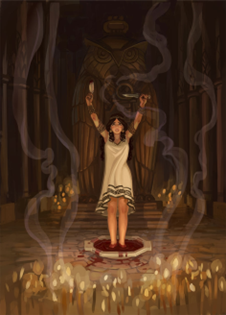 In the earliest days of Dungeons & Dragons, a stream of new and variant classes appeared in the pages of The Strategic Review¸ The Dragon and other fan magazines. One category of class was the NPC Class, a character class designed specifically for use by the DM’s non-player characters. Often, they would have various features that made them inappropriate for use by the players – either they were too strong or too specialised, or didn’t have class features that aided adventuring. However, they were often interesting to peruse, to get ideas about what existed outside of the printed rules, and spur ideas for adventures.
In the earliest days of Dungeons & Dragons, a stream of new and variant classes appeared in the pages of The Strategic Review¸ The Dragon and other fan magazines. One category of class was the NPC Class, a character class designed specifically for use by the DM’s non-player characters. Often, they would have various features that made them inappropriate for use by the players – either they were too strong or too specialised, or didn’t have class features that aided adventuring. However, they were often interesting to peruse, to get ideas about what existed outside of the printed rules, and spur ideas for adventures.
Jason Thompson’s Priestess supplement is of that sort. The class is inspired by tales true and fantastical of the ancient world; of priests that required to be in a temple to use their magic. Or – to be more true to the version Jason has created here – priestesses that must be in the presence of an idol to their god.
The priestesses described here are very much spell-casters: d6 hit dice, no proficiency with armour, and only proficient with simple weapons. Their spell list includes a handful of unique spells, but primarily draws from the cleric spell list with a few appropriate wizard spells thrown in for good measure. It is very much a support role, with only a few offensive spells in the list, although they have a larger range of offensive cantrips than the typical cleric, with chill touch, shocking grasp and poison spray being the additional cantrips they can cast.
The unusual feature of the class is that they must be in the presence of an idol of their god to cast spells at all, or use many of their abilities. It is a major hindrance of the class, with a 25 lb. stone idol required for 1st to 3rd-level spells; a 125 lb. idol is required for up to 5th level spells, and past that it gets even more difficult, with the top level idol weighing in at 15,625 lbs! At that point, the priestess is unlikely to venture far from their temple ever again. It is this restriction that is most flavourful, and makes the class unsuitable for use as a player character.
Being in the presence of an idol grants additional powers, typically the use of spells above and beyond the regular limit. To gain this extra power, “boons” must be acquired by sacrificing to the idol; exactly what sacrifice depends on the aspect of deity worshipped. It’s an evocative, possibly broken, mechanic.
The class is a strange one to evaluate. The simple fact is the requirement of having your idol with you in order to cast spells means that it is unsuitable for most campaigns. 25 lbs. for just 1st-3rd level spells is already very heavy, and it gets worse from there. In addition, the class has the melee combat strength of the wizard, without a compensating level of offensive area-effect spells.
Thus, it’s something used by the Dungeon Master, and at that point the class becomes too complex for easy use. There are a lot of features to remember here, and that is a problem. Do you want to spend an hour or more designing a foe that may only last 15 minutes in combat? And can you remember all it does in combat? The change away from the universal creation system used in 3E happened for a reason.
So, what then for the priestess? It’s a well-designed and lovely-looking product, with a lot of good ideas held within. It’s flaw is that the class doesn’t really fit with how many of us play the game today.
The best thing to do with it? Remove the idols from the class and turn them into special magical items that holy defenders of the temple can use; you could think of them as lair abilities. The delineation of the types of idols and abilities remain the same, and their function – as something that the priestess of that ancient, evil temple can use against the players – is made more broad.
I really like the ideas here; I just think they could be employed better in a slightly different manner.

Interesting. In your opinion, could this class, exactly as presented make a good basis of the only NPC spell casters for a nation or culture’s religion? (Assume no cleric or druid outside of rare player class types.) Could it be appropriate as an oracle the heroes must consult at key points in their struggles? Your excellent review seems to assume it would be either for players or their opposition. What about use in a campaign as patron or faith of an oppressed people, with the idols hidden in the wilderness where the party could get support, as the only power able to raise dead, etc.?